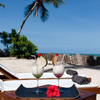|
|
|
|
|
|
|
|
|
Morro do Sao Paulo
|
|
 |
|
Morro de São Paulo is one of 5 villages of the island Tinharé in Bahia, Brazil, 272 km from the city of Salvador by route and 60 km by sea. The only way to go to the island is by boat or by regular flights that go from the airport of Salvador to the local airstrip. Cars are forbidden on Morro de São Paulo. The only method of motorized transportation on the island is by tractor, which carries passengers to other distant beaches, to pousadas (small hotels) on Third, Fourth and Second Beach (the closest to the village) and to the airport.
First Beach
The first summer houses were built on this beach. Today most of them have become "pousadas"/inns, stores or restaurants, and the few that remain are rented to tourists throughout the year. Similar to the houses converted into "pousadas", the old beach kiosks, almost all owned by local families. The first beach is also known for marine attractions. This beach also serves as the landing area for the tirolesa, or zipline, from the lighthouse.
Second Beach
This is well known especially among young people. The beach forms the stage for "rodas de capoeira" at the end of the day.
Third Beach
This beach also offers several accommodation options: tents, inns, restaurants and campsites. This beach is special due to Caitá Island, formed by a large barrier of coral reefs. The underwater view offers coral and fish of all colors and shapes. It's possible to rent all necessary equipment. Group boat trips can be arranged as well.
Fourth Beach
At first sight, Fourth Beach appears to have no end. A great barrier of coral forms innumerable natural swimming pools along this beach. Fourth Beach is much quieter than her sisters. Following Fourth Beach, the first entrance goes to Zimbo, a small village. Entering Zimbo, there are several trails that lead to the village of Gamboa, or to the mount [hill] of Mangaba.
Encanto Beach
Walking a little further, after crossing a mangrove swamp and a small river, is the Fifth Beach or Beach of Enchantment. Until recently, it was still considered part of Fourth beach, as well as all of the extension of beach to the source of the river that separates the island of Tinharé from the island of Boipeba. Before arriving to Boipeba, there is the small village of Garapuá, a fishing town.
Garapua
Along the way to the small neighboring island of Boipeba, there is the small fishing village with calm, crystalline waters. There are a few simple pousadas here.
Boipeba
The small island of Tinharé is separated by Rio do Inferno (Hell River). From Morro de São Paulo, tractors and small watercraft leave daily to bring travelers to this island.
Gamboa Beach
After a 20 minute walk along the beach of the Tip of the Rock, there is the town of the Gamboa. Gamboa, until recent years seemed to be kilometers away from Morro de São Paulo, for there was no sign of the tourism development that was bustling in Morro de São Paulo. It has continued being a peaceful fishing village. Perhaps this is the reason why some inhabitants have moved here and built houses and inns. However, although the infrastructure has developed somewhat, with good "pousadas" (inns) and restaurants and regional cuisine, the peaceful atmosphere of this fishing town is still preserved. In Gamboa, the waters are calm and crystalline and the beach serene, with fewpeople moving about. The majority of the island locals live in Gamboa.
Fort Beach
The Fortress Beach, reveals a strip of sand next to the natural swimming pools where it is possible to dive or snorkel.
|
|
|
|
|
|
 |
|
|
|
|
|
|
|
|
|
|

|
Anima Hotel
Praia do Encanto (the enchanted beach), south of Morro de São Paulo’s Fourth Beach, is one of the best preserved places ...
| |
|

|
Vila dos Orixas
Located at Praia do Encanto, the last and most serene beach of Morro de São Paulo. Vila dos Orixas Boutique Hotel is not...
| |
|
|
|
|
|
|
|
|
|
|
|
|
|
|
|
|
|
|